Festuca bromoides
Explore More :
Explore plus :
Overview
Aperçu
Regulation :
Remarques Réglementation:
Regulation Notes:
Distribution :
Répartition :
Festuca bromoides is native to Europe, Northern Africa and Temperate Asia (Caucasus and Western Asia) (Wiersema and León 1999; PIER 2008, USDA-ARS 2023). It has been introduced and become naturalized in Southern Africa and Mauritius, Australasia, North America, Central America, the Caribbean, Brazil and regions of Western and Southern South America (Sharp and Simon 2002; Barkworth et al. 2007; USDA-ARS 2023). F. bromoides occurs primarily in the western United States, with sparse distribution in the southern and eastern states, and the Canadian province of British Columbia and the Northwest Territories (Barkworth et al 2007; USDA-NRCS 2023).
Habitat and Crop Association :
Habitat et Cultures Associées :
Festuca bromoides prefers dry and nutrient poor soils within habitats such as grassland, chaparral, coastal scrub, heathland, pastures, riparian areas, rock outcrops, dry sclerophyll forests, alpine and subalpine zones, and disturbed areas (DiTomaso and Healy 2007; Weber 2017; Agriculture Victoria 2020; CABI 2023).
Festuca bromoides infests poorly managed grass and Trifolium spp. (clover) pastures as well as crops such as Triticum aestivum subsp. aestivum (common wheat) (Weber 2017; CABI 2023). F. bromoides can invade and outcompete native vegetation and it is one of the species threatening the habitat of Orthocarpus bracteosus (rosy-owl’s clover) in Canada (Weber 2017; CABI 2023).
Economic Use, cultivation area, and Weed Association :
Utilisation économique, zone de culture et association de mauvaises herbes :
Festuca bromoides can be used for livestock feed, however other pasture species are preferred by livestock (CABI 2023).
Duration of Life Cycle :
Durée du cycle vital:
Annual
Dispersal Unit Type :
Type d’unité de dispersion :
Floret
General Information
RENSEIGNEMENTS GÉNÉRAUX
Festuca bromoides is a tufted annual grass species that forms dense stands capable of outcompeting native vegetation for nutrients, water, and space (Weber 2017). This species reproduces by seed only that are effectively dispersed by attaching to animals and clothing or being transported in contaminated hay or seed (Weber 2017; CABI 2023).
The seeds of F. bromoides require an after-ripening period of a few months and the seeds can remain viable for at least 3 years, with potential to accumulate a large soil seed bank (Weber 2017).
Note: Some authors separate the genus Vulpia from Festuca because this group of plants usually have an annual life cycle duration, a single stamen per flower, and the tendency for self-pollination (cleistogamous); whereas, Festuca plants usually have a perennial life cycle duration, three stamens per flower, and are open-pollinated (chasmogamous). Plants traditionally assigned to the genus Vulpia have also been placed under the genus Festuca by some authors and are currently treated under this genus in the GRIN database and by the AOSA Rules (AOSA 2022; USDA-ARS 2023).
.Identification
Identification
-
Spikelet
Size
- Spikelet length: up to 14 mm (Tutin et al. 1980; Sharp and Simon 2002; Barkworth et al. 2007).
Spikelet size measurements from the literature:
- Spikelet length: 6.5 – 11.5 mm (excluding awns) (Tutin et al. 1980).
- Spikelet length: 5 – 10 mm (Barkworth et al. 2007).
- Spikelet length: 7 – 14 mm (Sharp and Simon 2002).
Shape
- Spikelet oblong, laterally compressed.
Surface Texture
- Spikelet surface thin and papery and may have some short stiff hairs.
Colour
- Spikelet pale yellowish brown coloured.
Other Features
Spikelet composition:
- Spikelet composed of 2 – 10 similar looking florets, distal florets usually reduced in size and staminate or sterile (Tutin et al. 1980; Sharp and Simon 2002).
Glumes:
- Lower glume 1.7 – 6 mm, one-half to three-quarters as long as upper glume; upper glume length: 4.3 – 10 mm (Sharp and Simon 2002).
- Lower glume 1-nerved; upper glume 3-nerved (Sharp and Simon 2002).
- Awn of upper glume up to 2 mm long (Tutin et al. 1980).
Spikelet disarticulation:
- Disarticulation of the spikelet occurs generally above the glumes and between the florets at the rachilla nodes
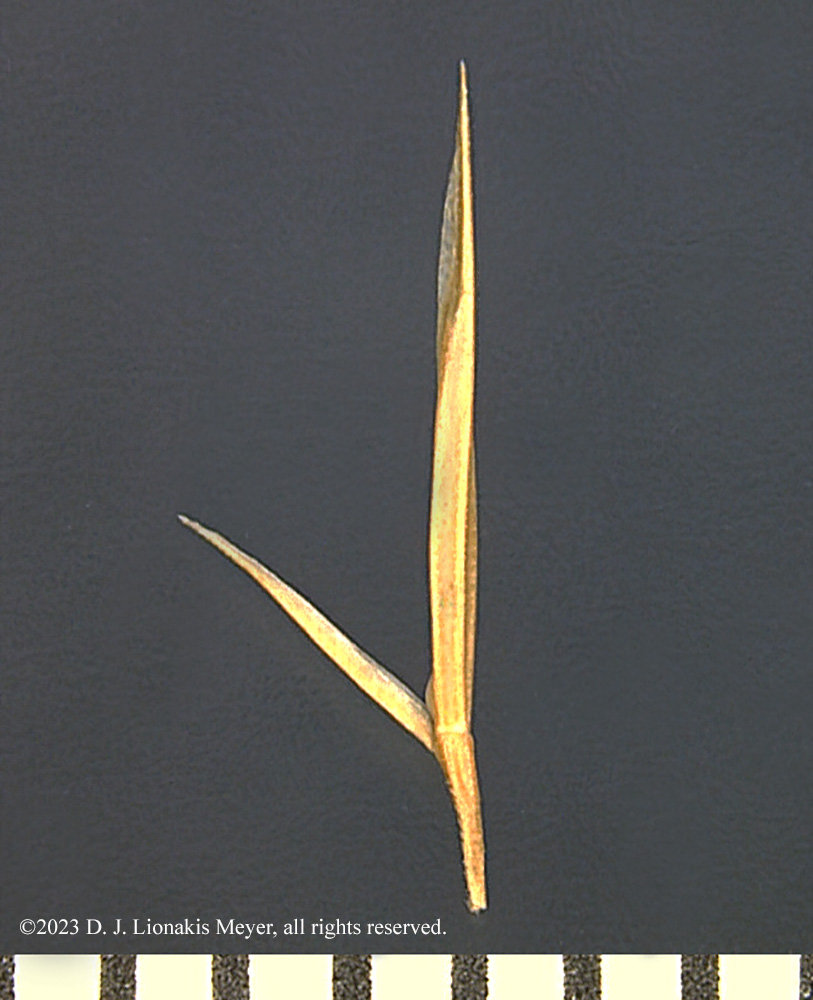
Festuca bromoides (brome fescue) glumes and attached pedicel; in this species the lower glume is one-half or more the length of the upper glume. [Vulpia bromoides] Scale in mm

-
Floret
Size
- Floret length*: 4.1 – 7.7 mm (average 5.9 mm); width*: 0.4 – 0.8 mm (average 0.6 mm)
- Awn length*: 2.8 – 13.3 mm (average 6.1 mm)
- Rachilla length*: 0.7 – 1.0 mm (average 0.8 mm)
*Note: minimum and maximum based on a random selection of 30 florets in normal range of this species using image measurement protocol (ISMA 2020). CDA-S-23310 and CDA-S-23286.
Floret size measurements from the literature:
- Lemma length 6 – 7 mm; width 0.75 – 1 mm (Musil 1963).
- Lemma length 4.5 – 7.5 mm; width 1.3 – 1.9 mm; lemma awn usually about the same length as lemma (Tutin et al. 1980).
- Lemma length 5.5 – 9.8 mm; awn length 5 – 12 mm; palea equal to lemma length; rachilla length 0.6 – 0.9 mm (Sharp and Simon 2002).
- Lemma length 4 – 8 mm; awn length 2 – 13 mm; palea length 4 – 6.3 mm, equaling or shorter than the lemmas (Barkworth et al. 2007).
- Floret length 4.6 – 5.6 mm; width 0.4 – 0.5 mm; awn 1.5 – 2 times longer than the floret (Bojÿanský and Fargašová 2007).
Shape
- Floret narrowly linear-teardrop shaped (narrowly lanceolate), dorsal-ventrally compressed.
- Floret body straight or arched backward.
Surface Texture
- Lemma thin and papery.
- Palea membranous and translucent.
Colour
- Floret pale yellowish-brown coloured.
Other Features
Lemma:
- Lemma tapered and extending into a long, straight awn.
- Lemma generally wraps around and covers the margins of the palea but usually leaving the palea keels exposed.
- Lemma 5-nerved.
- Lemma mostly smooth in lower one-third and covered with short stiff hairs in upper one-third to two-thirds.
Awn:
- Awn long and straight.
- Awn covered with short stiff hairs.
Callus:
- Callus glabrous.
- Callus narrow at outer edges and thicker in the center, looking like a gently rounded point.
- Callus about 0.2 mm long (Tutin et al. 1980).
Rachilla:
- Rachilla thin, cylindrical, and usually sparsely covered with short stiff hairs.
Palea:
- Palea equal to or slightly shorter than lemma.
- Palea 2-veined and 2-keeled.
- Palea usually flattened out at tip.
- Palea semi-transparent with caryopsis visible through palea, although palea may be in-rolled concealing view of caryopsis.
- Palea sparsely covered with short hairs between keels.
- Palea keel hairs (palea teeth) evenly spaced, short and stiff with broad base tapering to a point, hairs increase in length near tip of palea.
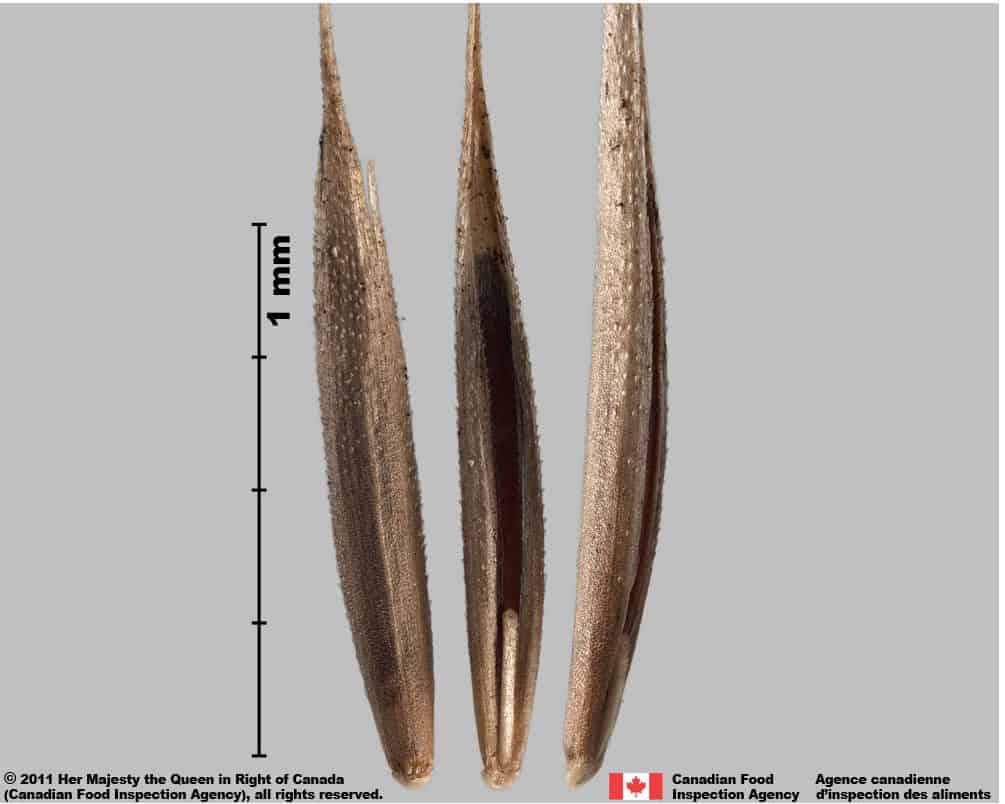
Festuca bromoides (brome fescue) florets

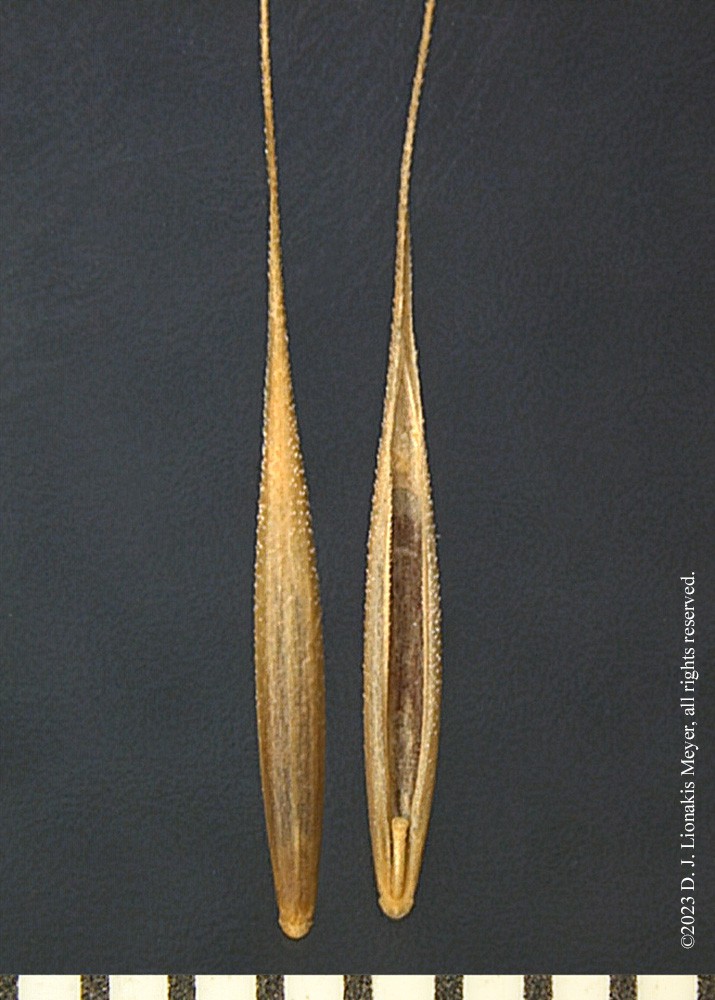
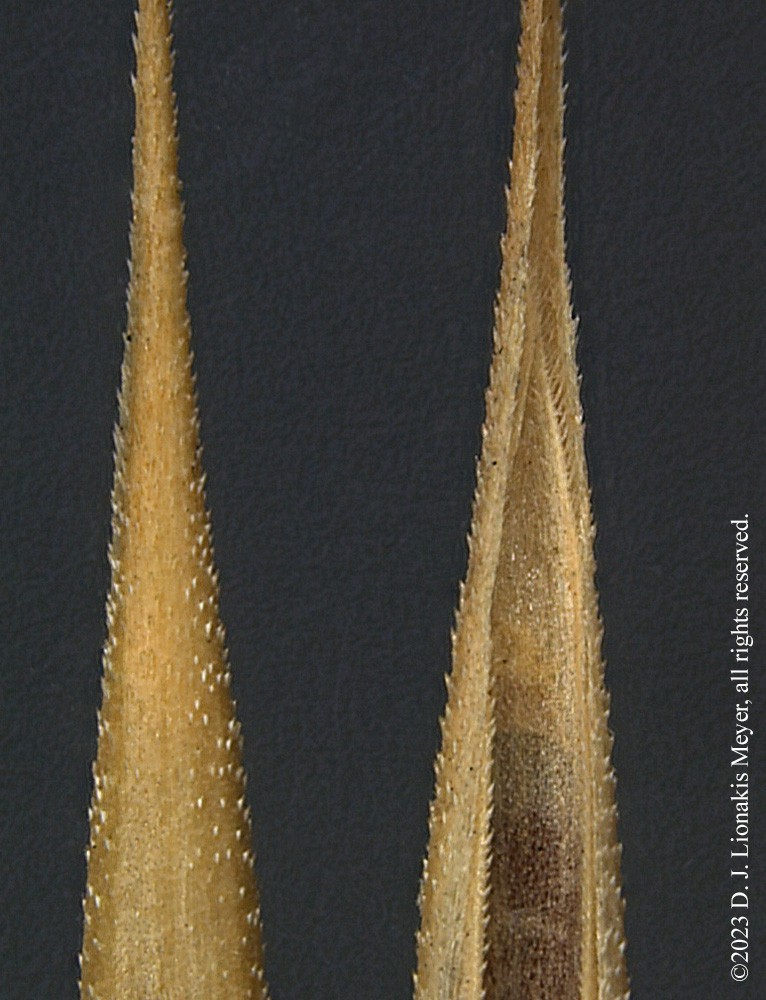
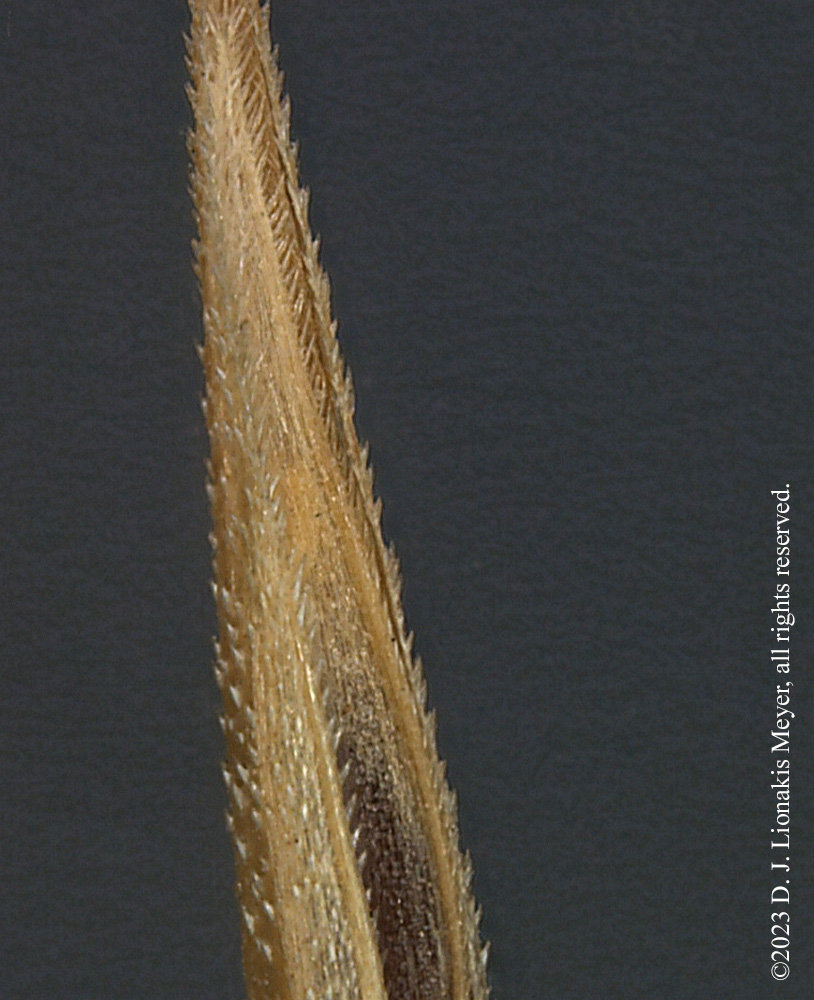
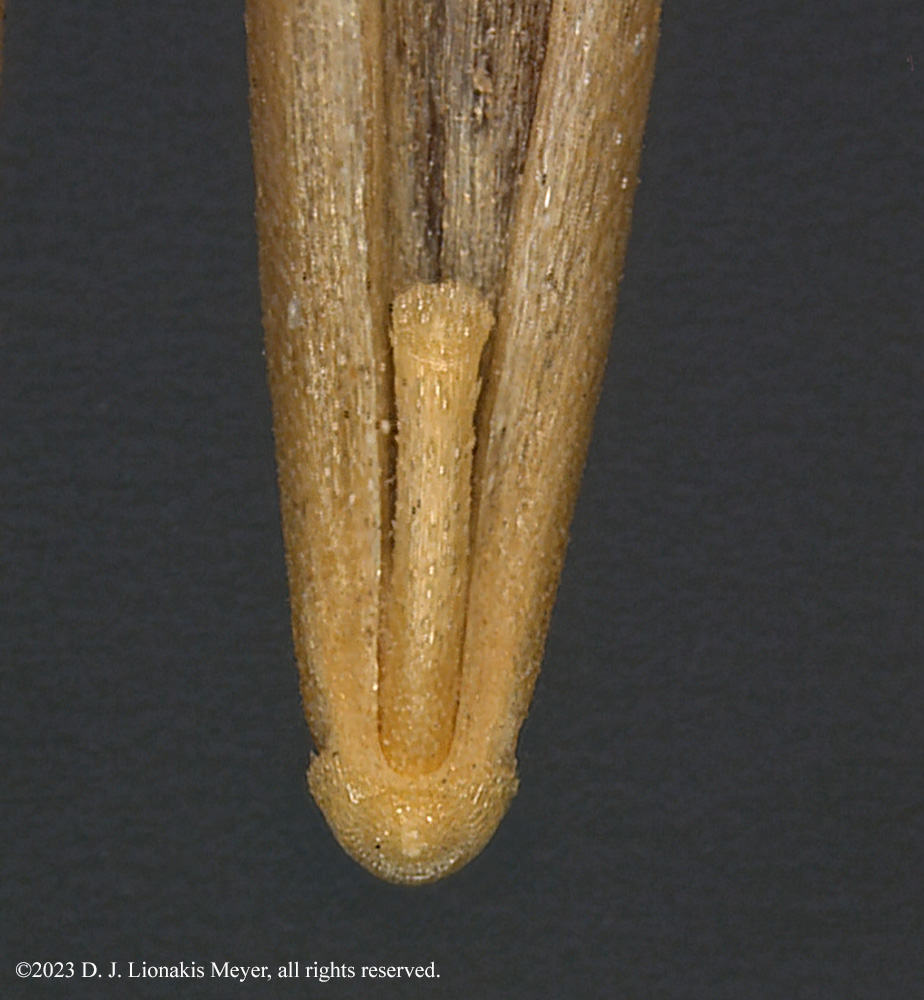
-
Caryopsis
Size
- Caryopsis length*: 3.6 – 4.8 mm (average 4.1 mm); width*: 0.7 – 1.1 mm (average 0.8 mm)
- Hilum length*: 2.9 – 4.2 mm (average 3.5 mm)
*Note: minimum and maximum based on a random selection of 10 caryopses in normal range of this species using image measurement protocol (ISMA 2020). CDA-S-59570.
Caryopsis size measurements from the literature:
- Caryopsis length 3.7 – 4 mm; width 0.4 – 0.5 mm (Bojÿanský and Fargašová 2007).
- Caryopsis length 3.5 – 5 mm (Barkworth et al. 2007).
Shape
- Caryopsis linear, slightly pointed at embryo end, dorsal-ventrally compressed, straight or arched toward embryo side of caryopsis, in-rolled on hilum side forming a deep longitudinal depression.
Surface Texture
- Caryopsis smooth, dull to slightly shiny, the lemma and palea may be adherent.
Colour
- Caryopsis reddish-brown coloured.
Other Features
- Hilum linear, about nine-tenths the length of the caryopsis, located in a longitudinal depression.
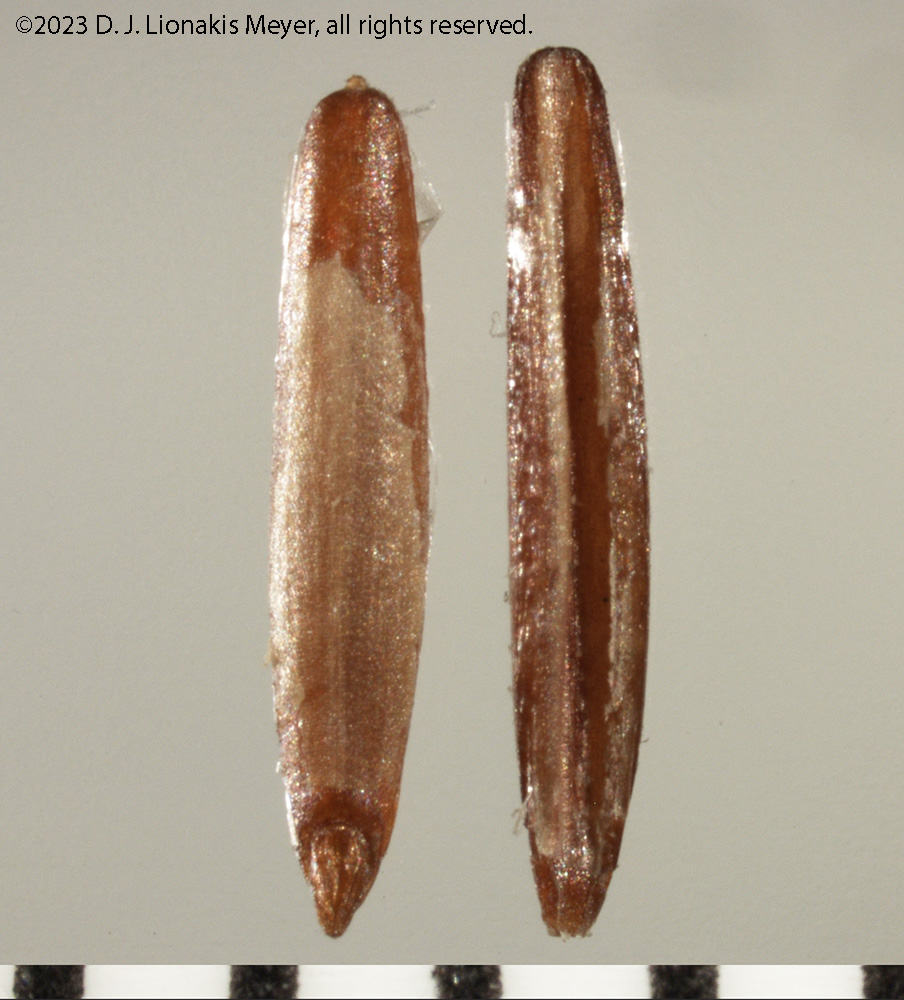
Festuca bromoides (brome fescue) caryopses, embryo view (left) and hilum view (right). [Vulpia bromoides] Scale in mm

-
Embryo
Size
- Embryo length*: 0.6 – 0.8 mm (average 0.7 mm).
- Embryo is about one-sixth the length of the caryopsis.
*Note: minimum and maximum based on a random selection of 10 embryos in normal range of this species using image measurement protocol (ISMA 2020). CDA-S-59570.
Shape
- Embryo teardrop shaped.
Endosperm
- Endosperm solid (Terrell 1971).
Other Features
- Embryo in lateral position (Martin 1946).

Festuca bromoides (brome fescue) caryopses, embryo view (left) and hilum view (right). [Vulpia bromoides] Scale in mm

Identification Tips
CONSEILS POUR L’IDENTIFICATION
In seed testing, the three most commonly encountered annual species of Festuca are F. bromoides, F. myuros L., and F. octoflora Walter. Florets of F. bromoides and F. myuros are very similar looking and are often confused.
- The lower glume of Festuca bromoides is one-half to three-quarters the length of the upper glume; whereas, in F. myuros the lower glume is usually less than one-half the length of the upper glume. Glume length is the single most important diagnostic character used to separate F. bromoides and F. myuros plants.
- Mature florets of F. bromoides appear arched in lateral view, while those of F. myuros tend to be straight.
- Florets of F. bromoides and F. myuros are larger than those of F. octoflora.
- The florets of F. bromoides and F. myuros are long and narrow, while those of F. octoflora are narrowly teardrop shaped.
Refer to the comparison chart under the similar species section of this factsheet for detailed diagnostic features of these three species.

Festuca bromoides (brome fescue) glumes and attached pedicel; in this species the lower glume is one-half or more the length of the upper glume. [Vulpia bromoides] Scale in mm






Additional Botany Information
AUTRES RENSEIGNEMENTS BOTANIQUES
Flowers/Inflorescence
- Inflorescence a sparingly branched, usually erect panicle or rarely a raceme (Tutin et al. 1980), up to 14 cm long (Sharp and Simon 2002).
Vegetative Features
- Plants annual, stems solitary or in tufts, 6 – 60 cm tall, usually upright (Tutin et al. 1980; Sharp and Simon 2002).
Similar Species
ESPÈCES SEMBLABLES
Similar species are based on a study of seed morphology of various species, and those with similar dispersal units are identified. The study is limited by physical specimen and literature availability at the time of examination, and possibly impacted by the subjectivity of the authors based on their knowledge and experience. Providing similar species information for seed identification is to make users aware of similarities that could possibly result in misidentification.
Festuca bromoides and F. myuros are commonly found as contaminants in seed lots. Festuca myuros is sometimes sold for erosion control. Festuca octoflora is also marketed for erosion control (USDA-ARS 2023) but the florets of F. octoflora are generally smaller in size and have much shorter awns compared to F. bromoides or F. myuros. Refer to the comparison table for detailed diagnostic features of these three species.
Two other species native to North America may occasionally be encountered in seed samples; Festuca microstachys, native to western North America from British Columbia to Baja California, and Festuca sciurea, native to the southeastern region of the United States (Barkworth et al. 2007; USDA-NRCS 2023). Floret and glume lengths of F. microstachys are similar to those of F. bromoides; however, depending on the botanical variety, florets and/or glumes of F. microstachys may be covered with hairs of various lengths or smooth (without hairs) (Barkworth et al. 2007). Festuca sciurea is generally smaller in size (lemma 2.5 – 3.5 mm; 3-nerved) and the hairs near the lemma tip are much longer (Barkworth et al. 2007).
Comparison table for mature floret and glume characters for Festuca bromoides, F. myuros, and F. octoflora. Measurements* shown are by first author using ISMA measurement protocol (2020).
| F. bromoides | F. myuros | F. octoflora | |
| Glumes | Lower glume one-half or more the length of upper glume | Lower glumes less than one-half the length of the upper glume | Lower glume one-half or more the length of upper glumes |
| Floret shape | Narrowly linear-teardrop shaped (narrowly lanceolate), dorsal-ventrally compressed; body straight or arched backward | Linear | Narrowly teardrop-shaped (lanceolate) |
| Floret length* | 4.1 – 7.7 mm (average 5.9 mm) | 5.5 – 6.9 mm (average 6.4 mm) | 2.5 – 4.7 mm (average 3.7 mm) |
| Floret width*
|
0.4 – 0.8 mm (average 0.6 mm) | 0.4 – 0.7 mm (average 0.5 mm) | 0.5 – 0.8 mm (average 0.6 mm) |
| Lemma surface texture and hairs | Mostly smooth in lower one-third and covered with short stiff hairs in upper one-third to two-thirds | Mostly smooth to covered with short stiff hairs, the upper margins may have long hairs | Depending on variety, smooth or covered with short stiff or longer soft hairs |
| Lemma awn length* | 2.8 – 13.3 mm (average 6.1 mm) | 5.0 – 13.1 mm (average 10.6 mm) | 0.6 – 2.8 mm (1.5 mm) |
| Callus | Smooth, without hairs, narrow at outer edges and thicker in center, looking like a gently rounded point | Smooth, without hairs, narrow at outer edges and thicker in center, looking like a gently rounded point | Blunt, narrow ridge, smooth in center and with short hairs at outer edges |
| Palea | Palea tip usually flattened out; semi-transparent with caryopsis visible through palea; palea may be in-rolled concealing view of caryopsis; sparsely covered with short hairs between keels | Nearly transparent with caryopsis visible through palea; slightly grainy textured between keels | Opaque to semi-transparent, grainy textured or sparsely covered with hairs between keels |
| Palea keel hairs (teeth) | Evenly spaced, short and stiff with broad base tapering to a point, hairs are longer near palea tip | Evenly spaced, short and stiff with broad base tapering to a point, hairs are same length all the way to the palea tip | Evenly spaced, short and stiff with broad base tapering to a point. |
| Caryopsis size* | 2.6 – 4.8 mm long; 0.7 – 1.1 mm wide | 3.2 – 4.5 mm long; 0.5 – 0.6 mm wide | 2.1 – 2.7 mm long; 0.5 – 0.7 mm wide |
| Hilum* | Linear; about nine-tenths the length of the caryopsis | Linear; about three-quarters the length of the caryopsis | Linear; slightly more than one-half the length of the caryopsis |
Click to select species
Cliquez pour sélectionner les espèces
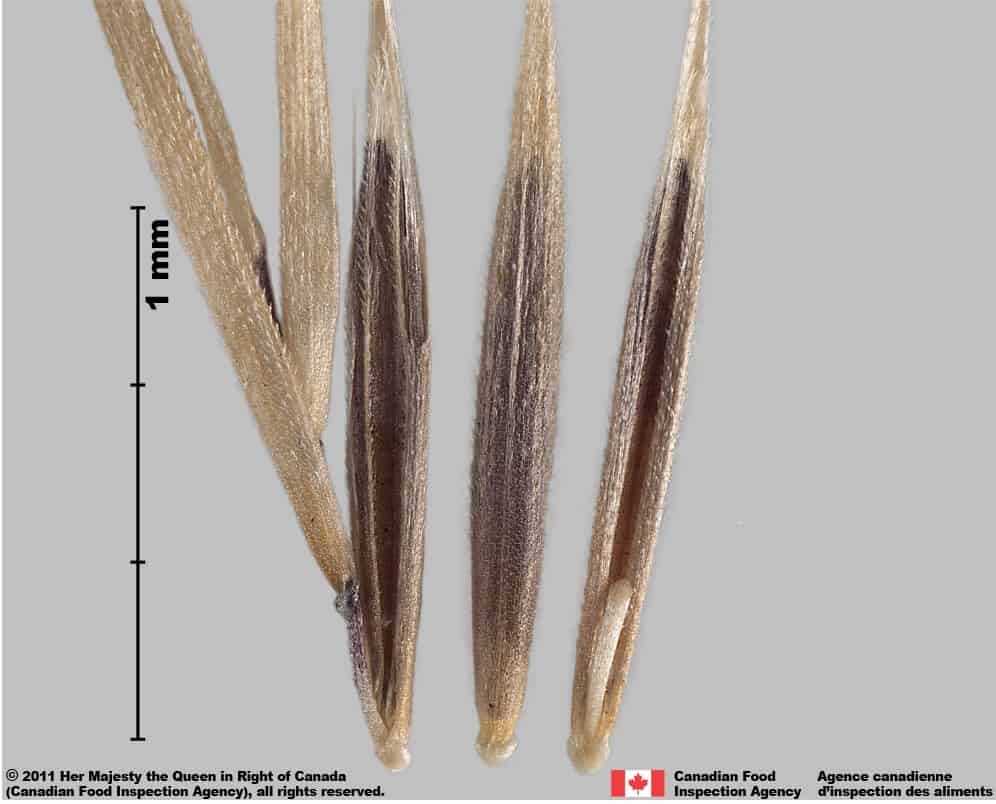
Festuca myuros
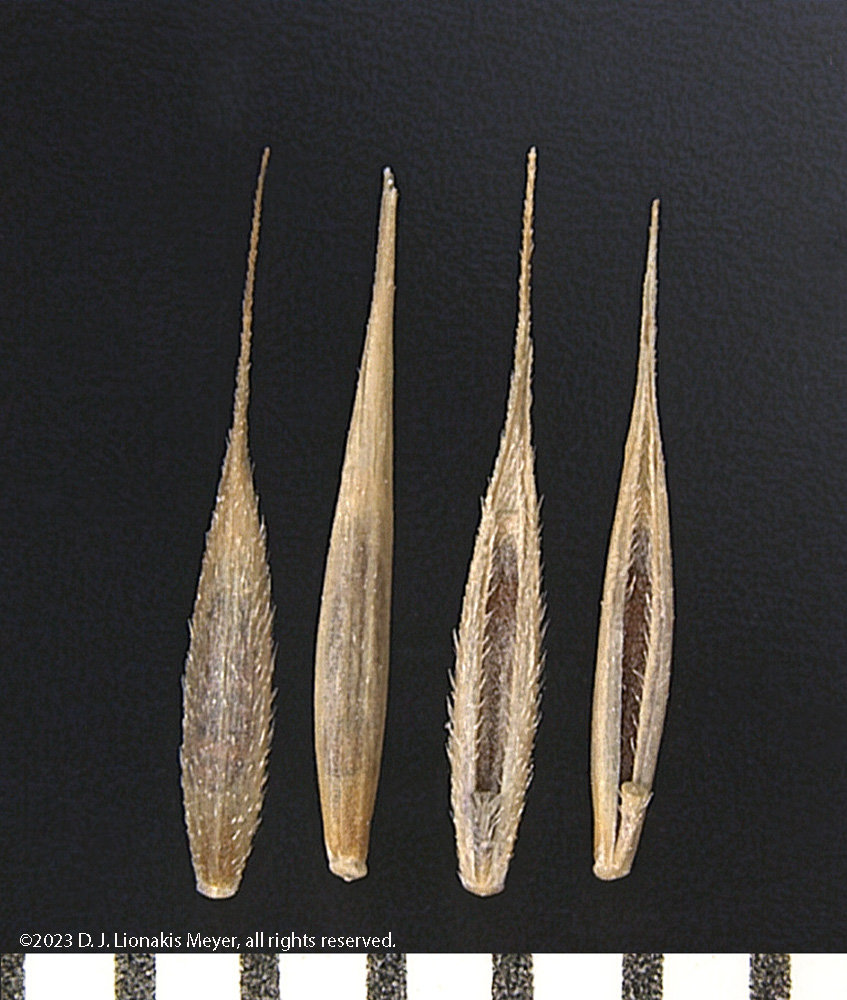
Festuca octoflora
Comparison Window
Fenêtre de comparaison
MAIN SPECIES
ESPÈCES PRINCIPALES
Festuca bromoides

Festuca bromoides
Poaceae
Festuca bromoides (brome fescue) florets
MAIN SPECIES
ESPÈCES PRINCIPALES
Festuca bromoides

Festuca bromoides
Poaceae
Festuca bromoides (brome fescue) florets, lemma view (left) and palea view (right). [Vulpia bromoides] Scale in mm
MAIN SPECIES
ESPÈCES PRINCIPALES
Festuca bromoides

Festuca bromoides
Poaceae
Festuca bromoides (brome fescue) close-up view of florets showing surface texture detail. Lemma tip and base of awn (left) covered with short stiff hairs. Palea view (right) showing short stiff hairs (palea teeth) along the palea keels transitioning into longer and more closely spaced hairs near palea tip. [Vulpia bromoides]
MAIN SPECIES
ESPÈCES PRINCIPALES
Festuca bromoides

Festuca bromoides
Poaceae
Festuca bromoides (brome fescue) close-up view of palea showing short stiff hairs (palea teeth) along the exposed palea keels transitioning into longer and more closely spaced hairs near palea tip. [Vulpia bromoides]
MAIN SPECIES
ESPÈCES PRINCIPALES
Festuca bromoides

Festuca bromoides
Poaceae
Festuca bromoides (brome fescue) rachilla is thin and cylindrical and covered with short stiff hairs. [Vulpia bromoides]
MAIN SPECIES
ESPÈCES PRINCIPALES
Festuca bromoides

Festuca bromoides
Poaceae
Festuca bromoides (brome fescue) caryopses, embryo view (left) and hilum view (right). [Vulpia bromoides] Scale in mm
MAIN SPECIES
ESPÈCES PRINCIPALES
Festuca bromoides

Festuca bromoides
Poaceae
Festuca bromoides (brome fescue) glumes and attached pedicel; in this species the lower glume is one-half or more the length of the upper glume. [Vulpia bromoides] Scale in mm
SIMILAR SPECIES
ESPÈCES SEMBLABLES
Festuca myuros

Festuca myuros
Poaceae
Festuca myuros (rattail fescue) florets
SIMILAR SPECIES
ESPÈCES SEMBLABLES
Festuca myuros
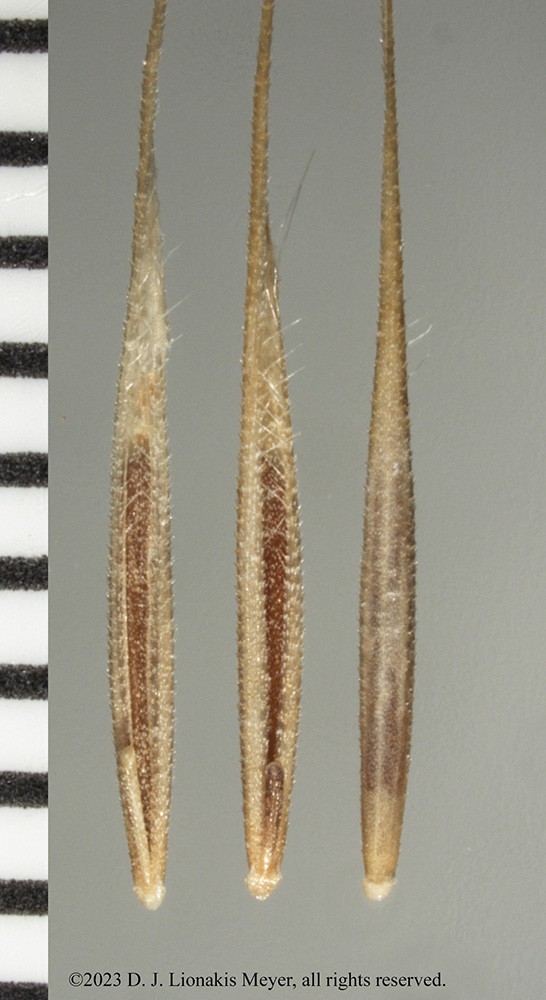
Festuca myuros
Poaceae
Festuca myuros (rattail fescue) floret lemma margins with long ciliate hairs. [Vulpia myuros] Scale in mm
SIMILAR SPECIES
ESPÈCES SEMBLABLES
Festuca myuros
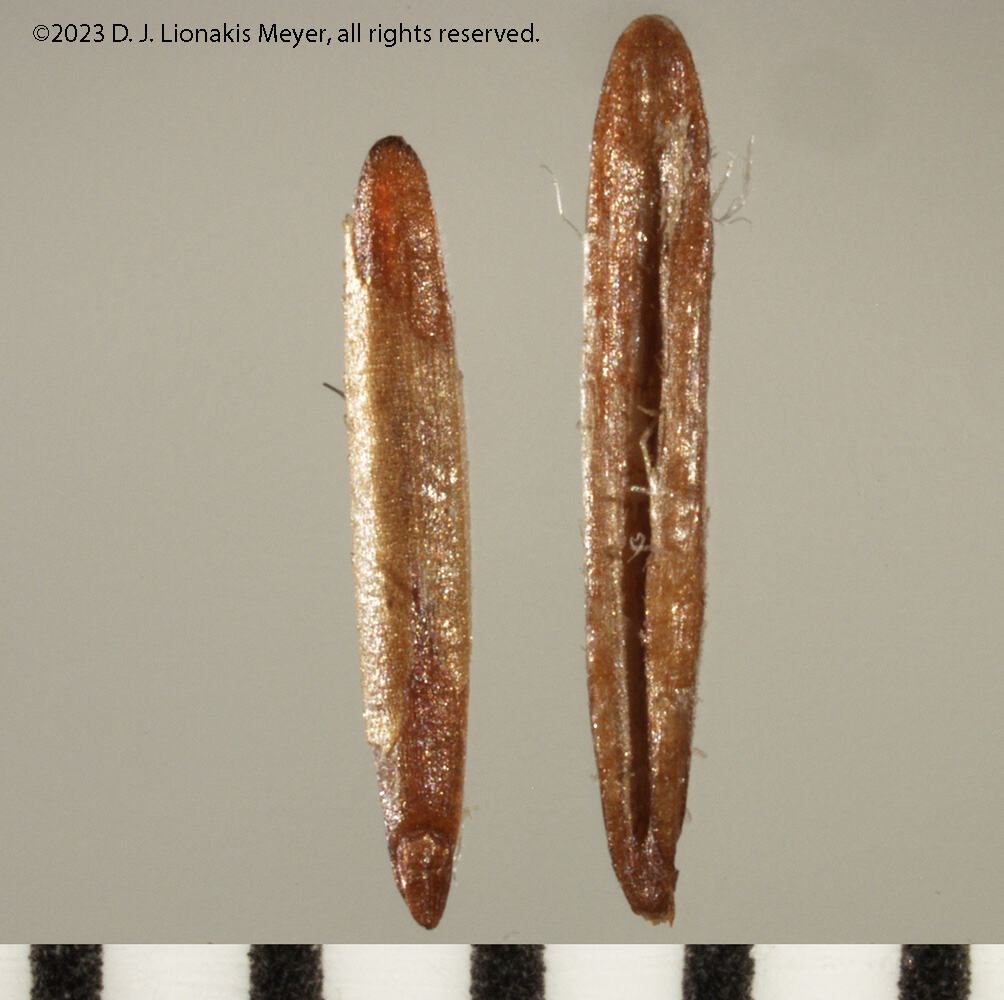
Festuca myuros
Poaceae
Festuca myuros (rattail fescue) caryopses, embryo view (left) and hilum view (right). [Vulpia myuros] Scale in mm
SIMILAR SPECIES
ESPÈCES SEMBLABLES
Festuca myuros
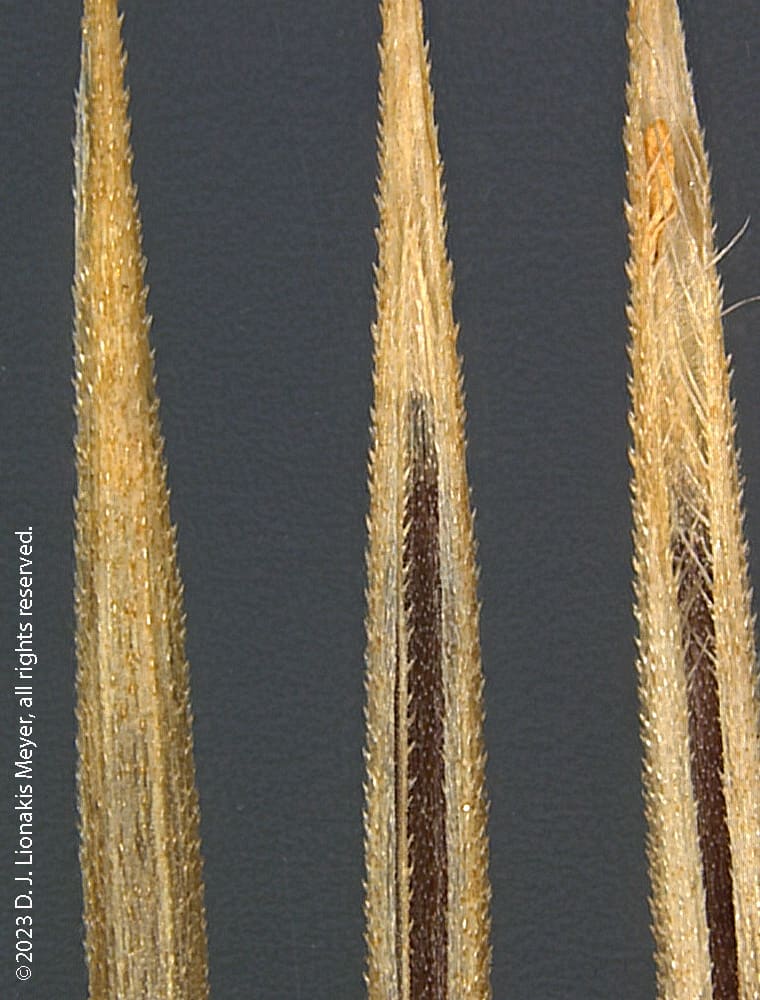
Festuca myuros
Poaceae
Festuca myuros (rattail fescue) close-up of florets, lemma covered with short stiff hairs (left), lemma margins without ciliate hairs (middle), and lemma margins with long ciliate hairs. [Vulpia myuros]
SIMILAR SPECIES
ESPÈCES SEMBLABLES
Festuca myuros
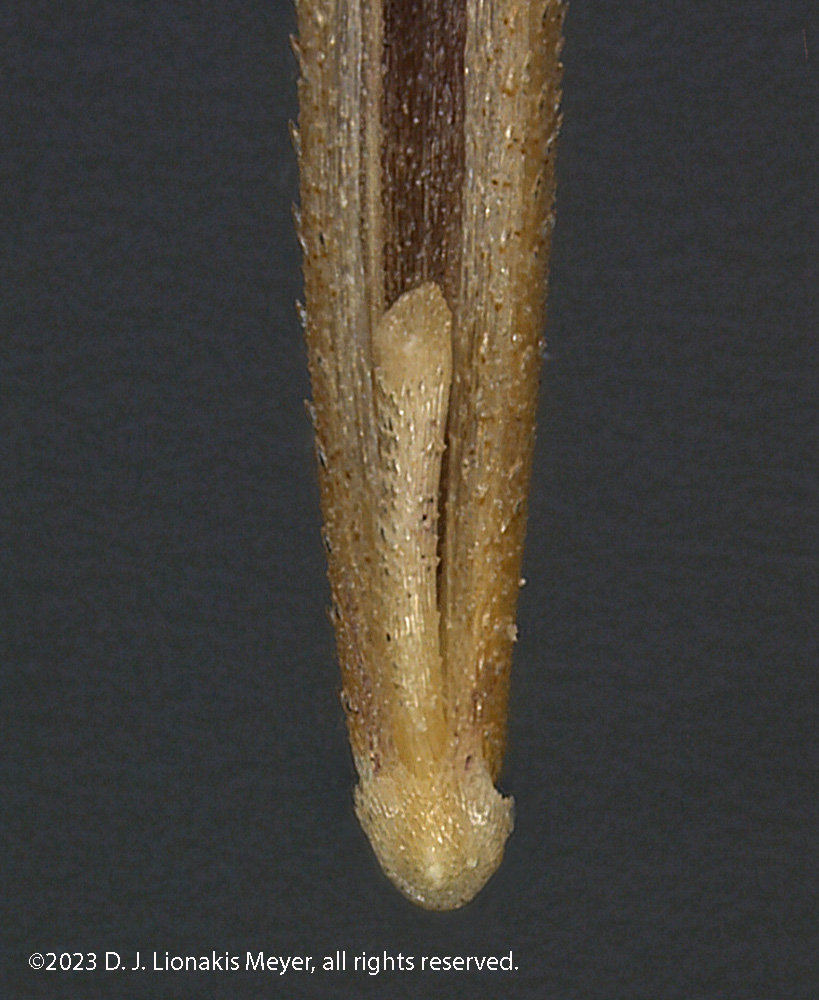
Festuca myuros
Poaceae
Festuca myuros (rattail fescue) rachilla is thin and cylindrical and covered with short stiff hairs. [Vulpia myuros]
SIMILAR SPECIES
ESPÈCES SEMBLABLES
Festuca myuros
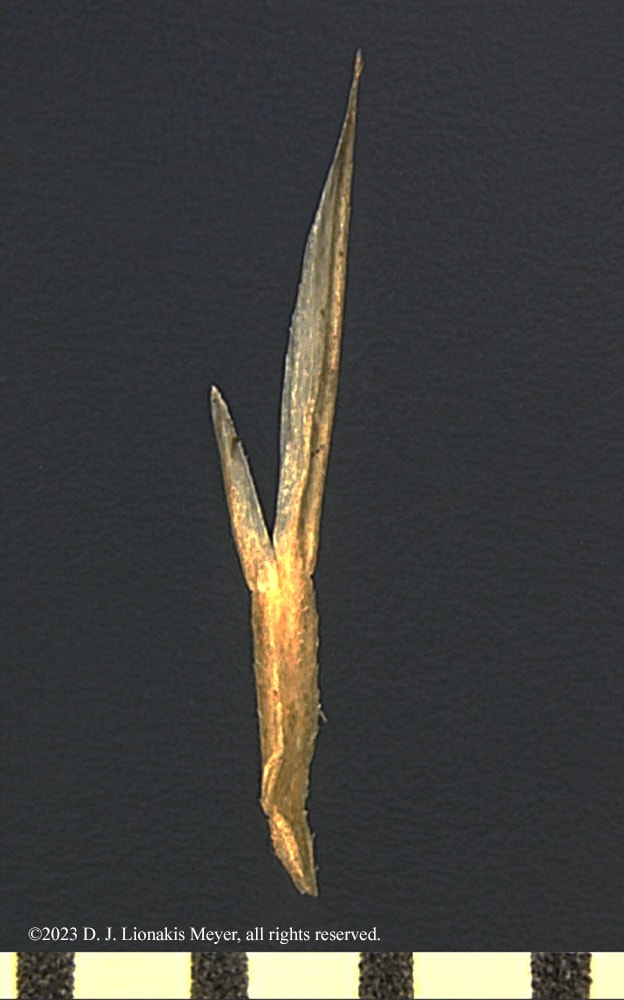
Festuca myuros
Poaceae
Festuca myuros (rattail fescue) glumes and attached pedicel; in this species the lower glume is less than one-half the length of the upper glume. [Vulpia myuros] Scale in mm
Need ID Help?
Besoin d’aide pour l’identification?
Reference(s)
Référence(s)
Agriculture Victoria. 2020. Squirrel-tail fescue (Vulpia bromoides). Victorian Resources Online – Invasive Plants. https://vro.agriculture.vic.gov.au/dpi/vro/vrosite.nsf/pages/weeds_grasses_squirell_tail_fescue Accessed August 25, 2022.
Association of Official Seed Analysts (AOSA). 2022. Rules for Testing Seeds. Volume 3: Uniform Classification of Weed and Crop Seeds. Association of Official Seed Analysts, Washington DC.
Barkworth, M. E., Capels, K. M., Long, S., and Piep, M. B. (eds.). 2007. Flora of North America Volume 24. Magnoliophyta: Commelinidae (in part): Poaceae, part 1. Oxford University Press, New York, New York.
Bojňanský, V. and Fargašová, A. 2007. Atlas of Seeds and Fruits of Central and East-European Flora: The Carpathian Mountains Region. Springer, Dordrecht, The Netherlands.
Center for Agriculture and Bioscience International (CABI). 2023. Vulpia bromoides (squirreltail fescue) – Datasheet. CABI – Invasive Species Compendium. https://www.cabi.org/isc/datasheet/117873. Accessed January 23, 2023.
DiTomaso, J. M. and Healy, E. A. 2007. Weeds of California and Other Western States. Vol. 2: Geraniaceae – Zygophyllaceae. Agriculture and Natural Resources Publication 3488. University of California, Oakland, CA.
International Seed Morphology Association (ISMA). 2020. Method for seed size measurement. Version 1.0. ISMA Publication Guide. https://www.idseed.org/authors/details/method_for_seed_size_measurement.html.
Martin, A. C. 1946. The comparative internal morphology of seeds. The American Midland Naturalist 36(3):513-660.
Musil, A. F. 1963. Identification of Crop and Weed Seeds. Agriculture Handbook No. 219. U. S. Department of Agriculture. Washington, D. C.
Pacific Island Ecosystems at Risk (PIER). 2008. Vulpia bromoides (L.) S.F.Gray, Poaceae. Pacific Island Ecosystem at Risk (PIER). http://www.hear.org/pier/species/vulpia_bromoides.htm. Accessed August 25, 2022.
Sharp, D. and Simon, B.K. 2002. AusGrass: Grasses of Australia. CD-ROM, Version 1.0 (Australian Biological Resources Study, Canberra, and Environmental Protection Agency, Queensland). https://keys.lucidcentral.org/keys/v3/AusGrass/key/AusGrass/Media/Html/VULPIA/VULBRO.HTML Accessed January 17, 2023.
Terrell, E. E. 1971. Survey of occurrences of liquid or soft endosperm in grass genera. Bull. Torr. Botan. Club 98(5):264-268.
Tutin, T. G., Haywood, V. H., Burges, N. A., Moore, D. M., Valentine, D. H., Waters, S. M., Webb, D. A. (Eds.). 1980. Flora Europaea. Volume 5: Alismataceae to Orchidaceae (Monocotyledons). Cambridge University Press.
United States Department of Agriculture-Agricultural Research Services (USDA-ARS). 2023. Germplasm Resources Information Network (GRIN). http://npgsweb.ars-grin.gov/gringlobal/taxon/taxonomydetail?id=16637. Accessed January 10, 2023.
United States Department of Agriculture-Natural Resources Conservation Service (USDA-NRCS). 2023. Vulpia bromoides. The PLANTS Database. National Plant Data Team, Greensboro, NC USA. https://plants.usda.gov/home/plantProfile?symbol=VUBR Accessed January 24, 2023.
Weber, E. 2017. Vulpia bromoides (L.) Gray in E. Weber (Auth.), Invasive Plant Species of the World 2nd Edition. A Reference Guide to Environmental Weeds. Wallingford, Oxfordshire; Boston, MA: CABI, 2016: pp. 494-495. https://cabidigitallibrary.org/doi/epdf/10.1079/9781780643861.0000 .
Wiersema, J. H. and León, B. 1999. World Economic Plants: A Standard Reference. CRC Press, Boca Raton, FL.




